#WWI battlefield tours
Explore tagged Tumblr posts
Text
Grays Essex newspaper ad from 1928 - promoting Great War battlefield tours.
Note the phone number...😲

2 notes
·
View notes
Text
Romance between guy hired to lay flowers on battlefield graves post WWI/guy hired to give officer tours to families even though it's really aggravating his PTSD
#I'm not actually joking I would read this#you're away from home in the last place you want to be during a time of massive social breakdown#that's romantic right
2 notes
·
View notes
Text
Benefits of Chauffeur Tours
The choice of a chauffeur-driven tour enhances the overall experience, offering comfort and flexibility. With a knowledgeable guide at the helm, you can customize your itinerary, ensuring that you don't miss any key sites or hidden gems along the way. The convenience of a chauffeur allows you to absorb the historical significance of each location without the stress of navigation, making your journey both educational and enjoyable.
The juxtaposition of Cornwall's serene beauty with the solemnity of Ypres and Normandy creates a tour that is not only informative but emotionally stirring. A chauffeur tour seamlessly connects these diverse locations, providing a comprehensive narrative of the impact of war on different landscapes and communities.
A Chauffeur Tour Cornwall, WWI Ypres Battlefield, and WWII D-Day locations is a unique and enriching way to connect with the past. From the rugged beauty of Cornwall to the solemnity of Ypres and the historic significance of D-Day, this journey offers a profound exploration of the human experience during two pivotal periods in history. Let the landscapes and stories unfold as you traverse these historically significant locations, creating memories that will last a lifetime.
Website: https://travelenglandtours.com/
0 notes
Text
Turkey Tour Packages
Introduction
Imagine yourself standing amid the ruins of an ancient city, the sun casting a warm glow on the stones beneath your feet. You can almost feel the presence of the people who walked these same streets thousands of years ago. This is just one of the countless experiences that await you in Turkey – a country where history, culture, and natural beauty collide in a breathtaking display of wonder. In this post, we'll explore some of the top Turkey tour packages – specifically 7-day and 10-day itineraries – to help you plan the perfect vacation to this enchanting land.
Turkey's rich history spans millennia, with numerous empires and civilizations leaving their mark on the landscape. From the Hittites and Phrygians to the Romans, Byzantines, and Ottomans, each has contributed to the country's unique cultural tapestry. Add to this the stunning natural beauty of places like Cappadocia, Pamukkale, and the Turquoise Coast, and it's no wonder that Turkey is a top destination for travelers seeking adventure, inspiration, and unforgettable experiences.
Whether you're a history buff, a nature lover, or simply looking to immerse yourself in a new culture, Tours turkey has something for everyone. And with carefully curated tour packages, you can rest assured that you'll see the best that this incredible country has to offer. So let's dive in and explore some of the most popular 7-day and 10-day Turkey tour packages available today.
7 days turkey tour packages
Classic Turkey: Istanbul, Cappadocia, Pamukkale, and Ephesus
For first-time visitors to Turkey, a 7-day tour that covers the country's most iconic sites is an ideal choice. This itinerary typically begins in Istanbul, the bustling metropolis that straddles two continents and boasts a history that dates back to ancient Byzantium. You'll have the opportunity to explore the city's most famous landmarks, such as the Hagia Sophia, the Blue Mosque, and the Grand Bazaar, before heading to Cappadocia, a region known for its otherworldly landscape of fairy chimneys and underground cities.
Next on the agenda is Pamukkale, a UNESCO World Heritage Site famous for its snow-white travertine terraces and the ancient city of Hierapolis. Finally, your journey will take you to Ephesus, one of the best-preserved ancient cities in the world, where you can wander the marble-paved streets once trodden by the likes of Cleopatra and St. Paul. This comprehensive 7-day tour offers an excellent introduction to the highlights of Turkey and is perfect for those who want to experience the best of the country in a relatively short time.
Of course, there are variations to this classic itinerary, such as including a hot air balloon ride over Cappadocia or a day trip to Gallipoli to explore the battlefields and memorials of WWI. With a 7-day tour package, the possibilities are endless and can be tailored to your specific interests and preferences.
10 Day Turkey Tour Packages
Discover Turkey: Istanbul, Gallipoli, Troy, Pergamon, Ephesus, Pamukkale, Antalya, and Cappadocia
If you have a little more time to tours to Turkey, a 10 days Turkey tour packages offers an even more immersive experience. This extended itinerary builds on the classic 7-day tour, adding additional destinations to provide a deeper understanding of Turkey's rich history and diverse landscapes. After exploring Istanbul, you'll head to Gallipoli, where you can pay your respects at the poignant memorials and cemeteries that bear witness to the fierce battles fought during WWI.
From there, you'll journey to the ancient city of Troy, immortalized in Homer's Iliad, before continuing to Pergamon, a city that was once an important center of learning and culture in the ancient world. Following your visit to Ephesus and Pamukkale, you'll make your way to Antalya, a vibrant city on the Turquoise Coast known for its beautiful beaches, charming old town, and impressive archaeological museum. Finally, the tour will conclude with an exploration of Cappadocia's unique landscapes and fascinating history.
0 notes
Text
I have been summoned! Thanks for the tag @ailendolin ♡
Favourite colours: Dark green and dark purple
Relationship status: Single
Three favourite foods: Pizza, cake, and crêpes
Song stuck in my head: Grand Escape by RADWIMPS (feat. Toko Miura)
Favourite show: Marvel’s What If...?
Last thing I googled: The different types of guardian statues in Asian temples (plus the general architecture of Kamar-Taj)
Dream trip: France and Belgium. I want to go on a battlefield tour and visit the main cemeteries of WWI. End the trip with a visit to Bruges.
Last song I listened to: The Beauty & The Tragedy by Trading Yesterday
Time: 5:40 PM
Thanks for the fun time! I’ll tag @kiki-shortsnout @jjackfrost and @wandereroftherealms
Tagged by the wonderful @thatgordongirl 💙
Favourite colours: green and dark blue
Relationship status: single
Three favourite foods: Apfelstrudel, Kaiserschmarrn, Kaspressknödelsuppe
Song stuck in my head: Cornwall My Home by Fisherman's Friends
Favourite show: BBC Ghosts
Last thing I googled: either a translation of a word or some research for my UK trip
Dream trip: New Zealand. Four weeks of exploring the two islands and visiting the LotR locations.
Last song I listened to: British Things by Horrible Histories (because I just watched the episode it's in)
Time: 2:48 pm
Tagging @magicaltear
9 notes
·
View notes
Text
Make Your Tour More Thrilled by Hiring WWI Battlefield Tours
There's many more chore at home, therefore an outing is like the reverse. It's like a breath of fresh air.
This blog is written to answer a few of your questions, such as why WWI battlefield tours a popular tour and who offers the best service for the same? Like most assessments, trying to choose if you should book a tour involves weighing the pros and cons. Why should you consider taking a tour? Tours aren’t for everybody, but the advantages of taking a tour can boost your outing.
Most recently, there has been a considerable increase in the mass of people wanting to visit the battlefield sites. This amplified interest stems from discoveries made in family history research and the wish to chase in the path of a WW1 forerunner, students studying the First World War in the school syllabus, and many well-liked plays, films, and TV documentaries on the topic. In comeback to the increased interest, the variety of facilities available for visitors has too developed. WWI battlefield tours are carried out by hundreds of visitors every year, whether you prefer to take a trip alone, with a guide, or with your friends and family.

The surprising range of WWI battlefield tours covers the key battlefield sites of the Great War across Belgium and France. Whether it’s visiting Flanders Field, walking the battlegrounds of the Somme, or standing on the forefront of the Ypres Salient, there’s nothing more worthwhile than visiting the battlefields of WWI. Led by one of our Specialist Battlefield Guides, whose knowledge and passion bring history to life; join us on a journey of Remembrance and discovery as we take an in-depth look at the events that unfolded 100 years ago.
If you want to hire a trustworthy WWII battlefield tour, Travel England Tours can be your one-stop. Here, we definitely go together with a faithful guide. Not only does this mean being with somebody who recognizes ample about the region you’re traveling in, but it means you will have somebody giving you information about the sights you’re seeing. Chronological facts can let you imagine an ancient city instead of just a pile of rocks and pillars when you’re looking at ruins. The best tour companies will make your experience fascinating and amusing.
To know more, please visit our website. https://travelenglandtours.com
0 notes
Text
The Story Of The Abandoned Car Factory Pragovka
Prague is a city of postcard-perfect architecture: from immaculate works of Gothic beauty – like St. Vitus Cathedral and the 13th century Old New Synagogue in Josefov – to the statue-lined Charles Bridge, or the monumental neo-Renaissance building of the National Museum looking out across Wenceslas Square. It is not a city that most would associate with industrial decay, however Prague’s former palaces of industry are no less grand, even while history is in the process of burying them.

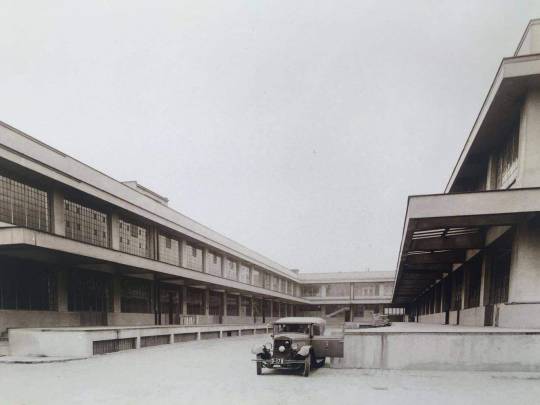
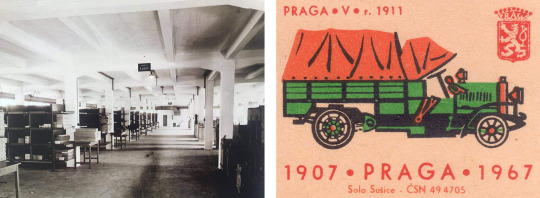
The Praga Car Factory Pragovka. | Photo via E-Factory.cz
The Praga Car Factory Pragovka on the city’s eastern edge was once the beating heart of the Czechoslovak manufacturing industry. It played a significant role in the city’s 20th century history, but it was here at the Prague’s darkest days was set into motion. In 1968 workers at Pragovka sent a letter to the Soviet Embassy requesting support in the fight against liberalisation. This letter, published in Pravda, would then be used as justification for the Warsaw Pact invasion of Czechoslovakia.
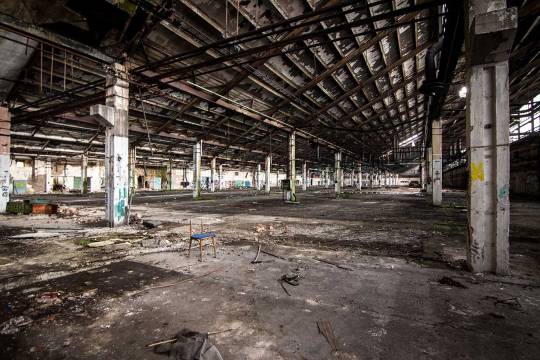
The Praga Car Factory today. | Photo Katka Havlíková
Pragovka is abandoned since the turn of the 21st century and is now a sprawling ruin, its extravagant factory halls succumbing slowly to time and nature. In 2017 I went to explore what was left of it. The Car Factory was founded in 1907 as a manufacturing site in the eastern suburbs of Prague, with just 30 employees. Two years later, its parent company adopted the name ‘Praga’ – the car brand used the Latin form of the city’s name in the hope of sounding more international. During WWI the Praga factory (then known as the First Czech-Moravian Machine Factory) supplied the Austro-Hungarian army; then after 1918 and the independence of Czechoslovakia, it began to focus more on passenger cars.

The main hall of the Pragovka factory in 2017. | Photo Katka Havlíková
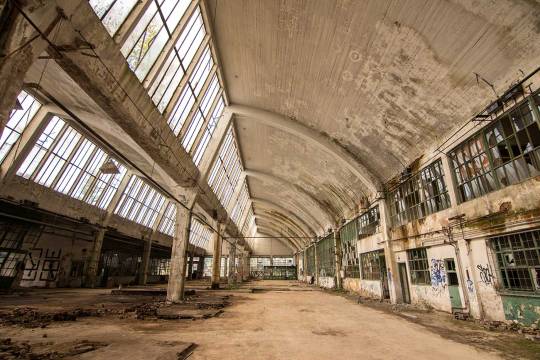
The large, angled windows allowed plenty of natural light to enter, reducing electricity costs. | Photo Katka Havlíková
In 1927 Praga was incorporated into the new ČKD (Českomoravská Kolben-Daněk) group, one of the largest engineering companies in Czechoslovakia. Among other vehicles (including tanks, locomotives, tractors, motorcycles and metro cars), ČKD produced cars under the Praga, Škoda and Tatra brands, and was famous for making the Tatra T3 tramcar – a design which would sell almost 14,000 units, and become an iconic sight on the streets of socialist cities from Sarajevo to Tashkent. Meanwhile as many as half of the taxis on Prague’s streets had rolled out of this factory.

Left: Cover of a 1962 sales brochure from Strojexport, featuring the Tatra T3 tramcar. Right: Vintage poster featuring the Tatra T77.
In recent years, the Pragovka complex has been recognised as a heritage site and some of its spaces have been developed into an arts district. There is a retro-themed ‘Pragovka Cafe,’ and the place hosts film screenings, concerts and festivals. Reportedly as many as a hundred local artists have studios now on the former factory grounds, while the large E-Factory building has been converted into a gallery space.
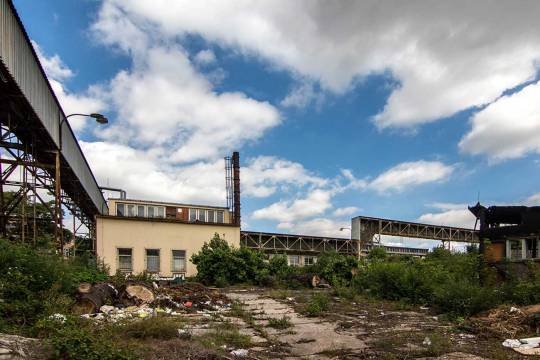
Some outer buildings still remain, linked by covered walkways. Other buildings have been bulldozed. | Photo Katka Havlíková
There’s talk of building apartments here too in future, a trendy new community rising up amidst the industrial decay. A large part of the complex remains off-limits for now though – and it was here that we entered. During the visit of Prague was fortunate enough to be offered a tour of its best ruins the local photographer Katka Havlíková.

Raised gas pipes above an overgrown courtyard. | Photo Katka Havlíková

The factory has been abandoned long enough for creepers and graffiti to cover many of its surfaces. | Photo Katka Havlíková

Katka picks a careful path through the debris-field, towards the first of the factory’s grand production halls. | Photo Katka Havlíková
She led us around the back of the factory where we scrambled up a slope of rubble to reach a promontory at the corner of the former yard. Ahead of us lay a sea of green. Thick vegetation hid the concrete courtyard, with only the occasional street light, rising like drowning hands from water, to suggest that anything unnatural lay beneath. The main buildings, those still standing, were just visible through the trees and so we cut a path down through the overgrown wreckage towards the old factory halls.
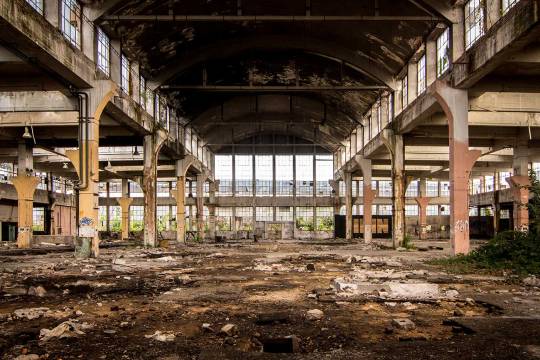
The largest of Pragovka’s manufacturing halls looks no less grand today with its full-height windows. | Photo Katka Havlíková
After poking around in a few of the outer buildings that rise now out of bushes and debris, we made it finally to the main manufacturing halls of Pragovka. It was strange to see a building this grand left to ruin. The complex was built back in a time when factories and power plants were temples of the people – places of pride, not merely function, their spaces defined with grand architectural flourishes. This main hall could have been a train station, not a car factory. Natural light illuminated the hall from floor-to-ceiling windows (much of their glass still intact), while pillars supported an arched ceiling high above.

Nature creeps into Pragovka – vines find a way inside through broken window, letterboxes, or any other breach in the outer wall. | Photo Katka Havlíková
We didn’t see the new arts district at all – a fact indicative of just how large this complex was – but it was hard to imagine how any small business or community project could successfully take over a space like this. The factory halls were beautiful, but built on such a scale that maintenance and repairs would be an extraordinary burden, particularly after all these years of decline.
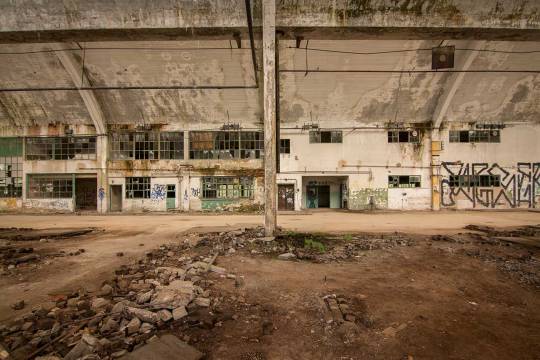
Two levels of offices lined the wall. | Photo Katka Havlíková

A staircase connects floors inside the main building. | Photo Katka Havlíková
The seeming inevitability of this factory’s ruin cast a melancholy mood over the few hours we spent wandering the halls of Pragovka. Right now, like this, with the warm sun slicing in sideways through the dirty glass windows, and the greenery of nature’s scouts – along with bursts of bright graffiti – lending fresh colour to the otherwise muted palette of pastel-painted walls and pillars: Pragovka might never look this good again.

Old ledgers amongst broken glass in the courtyard.| Photo Katka Havlíková
When Pragovka falls, much of its history will be buried with it; and perhaps for some, that might be for the best. Pragovka is remembered not only as the heart of the Czechoslovak manufacturing industry, but it is also a place where the communists made their stand – forever linking these buildings with a historic victory for the pro-Soviet movement. In 1968 the Soviet Union and its allies led an overnight invasion of Czechoslovakia – to suppress the Prague Spring, a growing liberalisation movement under First Secretary Alexander Dubček. Although history remembers the event as an act of totalitarian foreign aggression, that invasion was not, in fact, universally unwelcome.

A wall has collapsed to reveal the stairwell inside. | Photo Katka Havlíková
Numerous workers’ unions in Czechoslovakia supported Soviet intervention in their country, and one of the key triggers of the invasion was a letter of invitation, that was written here, at the Praga Car Factory. In 1971 the Czechoslovak journalist Josef Maxa authored A Year is Eight Months, which recounts the events of the Prague Spring and leading up to the invasion. “Moscow’s Pravda published a letter from ninety-nine workers in the Pragovka factory in Prague to the Soviet Embassy,” he wrote. “The letter denounced the Czechoslovakian enemies of socialism and of the Soviet Union.” That document was known as the “Letter of the Ninety-nine Praguers,” and it warned the Soviet Embassy how: “the manifestations of the democratisation of society in our republic threaten the building of socialism and in so doing, attack the blood-hardened friendship between the Czech and Soviet peoples” (as paraphrased by Martin Půlpán).
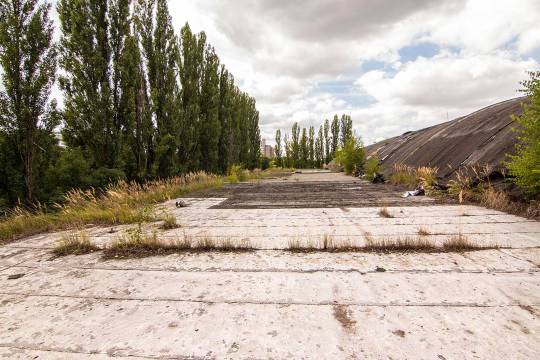
Rooftop above one of the manufacturing halls.| Photo Katka Havlíková
The letter claimed that all honest citizens of Czechoslovakia felt safer in the presence of Soviet and Warsaw Pact troops occupying their country. When Pravda printed the letter, on 30 July 1968, along with all ninety-nine signatures, the document would be used as justification for the swift invasion that followed in August. The incoming normalisation government that subsequently took charge of Czechoslovakia would valorise the authors of that letter – raising a memorial plaque at the main entrance to Pragovka, that read: “In the revolutionary tradition of this great workers’ nation, a letter with ninety-nine signatures was sent to the USSR in the critical year of 1968, requesting support and assistance in fighting anti-socialist forces.”

A bright and airy side room near the main factory floor. | Photo Katka Havlíková
Nowadays that plaque is long gone. The gates of Pragovka stand barred, and the halls where the letter was written are lost to a maze of rubble, weeds and graffiti. The factory’s decline today is an inevitability – it is a temple to a lost industry, a relic displaced from its time and no longer fit for purpose in the new industrial landscape of the Czech Republic.

The wall in a former office space. | Photo Katka Havlíková
Though Pragovka’s political history likely doesn’t help to endear these halls to the citizens of contemporary Prague – and it’s hard not to read some level of symbolism as this celebrated factory, once enshrined like a victorious battlefield in Czechoslovakia’s communist historiography, is slowly carved up, and crushed, by the oncoming future.
--
by Darmon Richter
[adapted with permission from an article at Ex Utopia]
22 notes
·
View notes
Text
The Story of Us
Fandom: Wonder Woman Pairing: Diana x Steve Rating: T Words: 4363 (!) Summary: Diana and Steve are soulmates who met during WWI. Unfortunately, they didn't get a happy ending. Present day Diana is a writer, who using the memories of her past life, put their story into a novel. Her memories are all she has of Steve, until... Notes: For the @wondertrevnet‘s Valentine Event. Warnings: Character(s) Death & Reincarnation. Angst with a happy ending.
Read @ AO3
“Diana… whatever happens, just remember that I love you.” Steve said as he held onto Diana’s face in his hands.
“Steve…” Diana’s own voice was barely a whisper.
*****
And Diana wakes, she opens her eyes to find them blurry with tears, so she closes them again and takes a deep breath, centering herself in the here and in the now. What haunts her is her past, a past that was quite literally a lifetime ago. But the pain that came with the memories was as raw as a recent and the most profound love lost.
Diana knows that she is only remembering. But the memory of Steve is hard and raw, they were soulmates. A thing so incredibly rare and precious that, their love had been a shiny beacon of light amongst the darkness of the war. What worries her is the fact that she can remember. By all means, she shouldn’t and that makes it all the more painful, for their love was so very short lived before both of them lost their lives.
Diana has made her diligence, she has spent hours upon hours on the internet, trying to find other people that, like her, remember their past lives and past loves. The small pool of people she has found has been a source of comfort. But she has not found Steve yet.
Diana opens her eyes, turns her head to the light coming from the small crack of the curtains, the sun’s already up and she needs to get up soon. She has a meeting with her editor at eleven thirty and it’s already nine. She chose to have a writing career, even when her mother frowned and disapproved, as a compromise, Diana took an extra degree in history and now, she was working full time at the Louvre, which allowed her to have time to write the books she wanted to write. Thankfully, she was also given the opportunity to do book tours and signings as necessary.
Diana tossed the covers of her body and sat up, stretching her body and willing herself to leave the comfortable nest her bed was, she tossed her legs off the side of the bed and put her feet on her slippers. She stood and made her way to the bathroom to relieve herself, once she’d done so, and after washing her hands, she splashed cold water on her face to clear away any sleep. After drying her face, she went back into her room and began to change into jeans and a comfortable sweater.
Diana kept the slippers on and made her way into the kitchen, she made herself a coffee and some eggs. She ate slowly, savoring her food. She made herself a second cup of coffee and then she went back to her room, only then did she brush her hair, she kept it loose and simply wore a headband on it.
Diana made her way to the small balcony of her apartment. She could clearly see parts of Paris and while she did so, her mind turned to her newest book.
Diana’s first book had been an overnight hit. ‘The Story of Us’, had been hers and Steve’s love story, she had written it as it had happened, even with the unhappy ending that marked their separation and eventual deaths. Many had rained praise upon her work, calling it moving and heart wrenching.
Diana simply had taken it in stride, she had been grateful for the amount of goodwill her book had given her. And now, as she prepared herself to edit her second book, she often wondered if Steve was somewhere out there, if he had read her book and realized what she had done. That she had - with all the love she had in her heart - sang their love song to the world.
And now, Diana had a second book out and - so far - had been getting good reviews. But it’s nothing compared to her first, she finds that she doesn’t mind. If the story of the love she shared with Steve was the greatest thing she wrote, she would be content with it.
Diana closed her eyes, feeling the warmth of the sun hit her face and her mind began to wander.
*****
“Miss Prince,” General Jones had spoken. “Please meet General Steven Trevor, he’s one of our best agents, recently returned from a mission.”
Diana looked at the man whom General Jones had identified as Steven Trevor, tall and blond with slight tan to his skin that brought out his beautiful blue eyes, his smile was friendly and while he carried himself with pride, there was no arrogance to his stance. She extended her hand. “Pleased to meet you, General Trevor. I am Diana Prince.” She gave him a smile and his extended.
But something happened when Steven took her hand in his. Diana felt her body do a full body shiver, and she knew that Steve had felt it too by the way his eyes widened. Steve recovered quickly. “It’s lovely to meet you Miss Prince. Thank you for helping with the war effort. And please, call me Steve.”
Steve’s voice had a pleasant tone and Diana, who had read so much about soulmates, knew what had happened. She had just met hers. They were soulmates. But Diana knew that not all soulmates were romantic. Whatever happened between them, it would either grow into an unforgettable romance or, the deepest and most profound friendships. “No need to thank me, I should thank you. You’re the one who is risking his life out in the battlefield, I’m simply translating documents.”
Steve had not let go of her hand, and Diana found herself reluctant to let go of his. Only doing so in order to avoid any awkwardness around them. Steve’s smile grew. “And those documents are important! They don’t trust just anybody with them, I should know. So don’t sell yourself short Miss Prince, any little counts.”
*****
Diana opened her eyes again, only to blink as the sun shone in her eyes. She looked at the mug on her hand, half of it was still full, but had gone cold as she had been lost in the memories of her past life.
Diana went back inside and looked at the clock, it read ten-thirty. She still had an hour before she met with Etta. Diana smiled at the thought of Etta Candy. She and Etta had met during the war too, but Etta didn’t remember her past life and Diana didn’t begrudge her that. But it struck her as funny that in her past life, Etta had been Steve’s secretary and now, she was her editor.
Diana put the mug down on her bedside table and sat on her bed, it was Saturday and she was in no rush yet, she had half an hour before she had to leave to meet Etta. So she took the book she had and read a little.
**
“I’m telling you Diana,” Etta said as she went over some changes she wanted to make. “It will be a good book, honestly, I don’t know how you do it. You have one that’s a complete success and the second one is not doing badly at all. And now you have another finished? I wish all my clients were like you.”
Diana smiled at Etta. “I simply write daily, it’s a good way to wind down from work. And I’m glad to hear that you like this book too.”
“It’s fantastic dear. And I’m very happy with you. Very much indeed. Oh and don’t forget, you have a book signing in a week. So brace yourself, because you’ll probably get plenty of questions from ‘The Story of Us’.”
“I know,” Diana sighed and nodded. “That’s fine, people are curious, I’m expecting all sorts of questions and I’m ready to answer.”
“Good, good. Then, read the edits I want you to make on this one and then we’ll talk about it, yes?”
“Of course.”
*****
“I can’t believe they’re sending you to Germany!” Steve’s indignation was slightly annoying. “You’re not a spy or an actress, you’d be in deep enemy territory and that’s not right.”
“Steve,” Diana had been calling him that due to his insistence. “I can manage. I am not afraid, when I signed up to help with the war effort, I knew this was a possibility, you don’t need to worry.”
Steve ran his hands through his hair. “Well, I do. And I won’t apologize, it’s a high risk and I’m not happy. At least they’re putting you with my team, that way you’ll be as safe as you can be with us around.”
“Excuse me?” Diana didn’t like his tone, so she stood tall and squared her shoulders. “I’ll have you know General, that I am quite capable.”
Steve raised his hands in a placating manner. “I know Diana, but this active combat and you’d be in the thick of enemy territory. You have never gone undercover, and while I have no doubt that you’re quick on your feet and a fast thinker, I still feel uneasy. You’re heading for dark waters, more correctly, waters that you have not swam in before.”
Diana relaxed a bit. “I understand and I thank you for your worry; but I am sure I will be able to handle whatever comes my way.”
“If all goes wrong, I’ll always be near. Just in case. We’re partners now, and I’ll always have your back.”
Diana smiled. “Thank you Steve.”
*****
Diana sat on her desk, typing away her new would-be novel, but her mind kept getting distracted. Next Saturday she had the book signing event, and that usually came with plenty of questions of both her first book and the new one.
Diana didn’t mind the questions, she enjoyed talking to people about her book. But there was one question that kept popping up: ‘Why the tragic ending?’. No matter where she went, the question was always asked without fail. She had perfected her answer by now, but she could still see the disappointment of whomever asked the question when she would reply: ‘Because it was an unfortunate event, Arthur had no way to survive the explosion. And Amelia was too sick to make it.’
Because Diana could hardly say: Because that is what happened, and this is my previous life. Because Steve and I didn’t have a happy ending, only a brief and intense love. One that still survives.
*****
Diana and Steve had been working together for nearly six months. And during that time, they fell in love. Being soulmates had turned out to be a blessing. The love that bloomed was one many would envy, she felt complete whenever she was with Steve. It also came in handy, for they would use their relationship as a cover, a way to meet and exchange secrets away from prying eyes. It was easy to blush, look down, smile and say that it was a lover’s meeting. Not a lie, but not the complete truth.
Their love had grown deep roots in their hearts. Diana could hardly wait to see Steve, and Steve would always find something to give her; little trinkets that she could keep with her.
One of their missions was attending a ball. Steve had all but devoured her with his eyes when Diana met him, her blue dress almost a perfect match to his eyes. They had danced and mingled, doing their best to remember every single detail of any conversation they took part.
It had been the only time they had shared a bed. Their passion unleashed, breaking like a dam and overflowing their senses. Both overcome with both love and a deep desire for one another, to the point where Diana felt like she was drowning. But it had been such a sweet feeling, that she couldn’t and wouldn’t object to it. Diana hated parting from Steve the following morning.
*****
Diana clearly remembered the first time she had dreamt of Steve. She had been fifteen, tired from school and feeling a bit lonely. She had always felt so, like something was missing and she couldn’t pinpoint what it was.
Diana had gone to bed early, and her dreams had been filled with a deep fog. She had felt lost and alone, yelling for someone, for any help. Then, she remembered how the fog parted and the sunlight had filled a palace ballroom and there stood a man, one that she had never met. But who, upon seeing her, smiled bright and wide and offered his hand, calling for her.
Diana had caught her reflection on a mirror, she was older and wore a blue gown. She went instinctively to the man, then, she heard herself say: Steve. They danced all night long. And Diana had woken in tears.
And then the dreams and memories began to come. One by one, they made themselves known, and like a puzzle, everything began to make sense, with all the pieces finally in place, Diana understood and she grieved. She had had a soulmate and she had lost him before they could have had a life together.
**
“You seem upset.” Mera’s voice broke the silence of her office. “Is everything alright?”
Diana looked at where Mera stood, standing on her open door, Mera cut an impressive figure. Tall and pale and redhead with kind blue-green eyes, Mera could pass for a supermodel, instead, she was an archaeologist and as of late, a good friend of hers. She tried to smile. “Yes. Just didn’t sleep well last night.”
“Mmh,” Mera frowned and her lips thinned. “Nightmares?”
“No. Simply restless.”
“Ah,” Mera nodded. “I understand that, it happens. Drink some chamomile before bed, it should help.”
This time, Diana did smile. “I will thank you.”
“Excited for the book signing?”
“Yes. I can’t wait to see what they ask. It’s always exciting, and it’s also very lovely, you know? All these people come because they like my book and now, they want to read the new one. Or they have read it already and they have questions. It’s always fun.”
Mera gave Diana an apologetic smile. “Sorry I can’t come. But you know I’m meeting Arthur’s parents, they’re visiting and I’m taking them for brunch.”
“It’s fine Mera,” Diana’s smile softens. “I understand, you enjoy your time with Arthur and his parents.”
“Thanks, see you on Monday then.” With that, Mera left to continue whatever it was that she was doing.
Diana stared at Mera’s retreating figure until she was no longer in sight. Then with a sigh, she opened her emails and went through her work, but her mind wasn’t really into it. So she paused for a moment, closed her eyes and did some breathing exercises, once she felt centered, she opened her eyes and continued to work. But she could tell it was going to be a long day.
*****
Diana’s mission ends sooner than Steve’s. It’s almost immediately after the discovery of a new gas made to kill. Diana’s hands shake as she translates the effect on the gas, has to remind herself to breath in through her nose and exhale through her mouth. Everything’s horrible and she is terrified of what’s to come.
Steve has another mission, but he makes sure to escort her back to France, from where she’s meant to take a ship back to London. Diana doesn’t want to leave him behind, the feeling of dread setting into her stomach.
“Don’t make me go,” Diana whispers, looking deep into Steve’s eyes. “I can’t bear to leave you behind.”
Steve to his credit, takes it well. He simply smiles and takes her face between his hands. “Diana, you knew this could happen, the war isn’t over and my job is not done. What you did has given us an advantage, but I must continue to fight. I promise you, that after the war is over, I will come and find you. We’ll be together forever then. Until death do we part.”
Diana’s eyes glaze over with unshed tears. “Steve,” her voice is barely above a whisper. But she knows that he is right. She must leave for the safety of England, else she would be a target with a price on her head. After all, she was the one who was in charge of paperwork, any leads would come back to her. “Promise me. Swear it even, come back to me. Come and find me.”
“I will, Diana. I will come and find you.” Steve looks at Diana in her eyes. His own are serious and solemn, his face still and then he leans forward and he kisses her with all the love and passion he has in him.
Diana kisses him back, holds onto him until she must leave and board the ship. She stands in the deck, watching as Steve grows smaller by the second, until he is no longer visible. “I’ll be waiting, Steve.” She says to the wind, in hopes that her voice will carry over.
**
Etta Candy is the one who welcomes her back to London. She receives praise for her work, accolades come easy, but she is quiet and subdued. Leaving Steve behind, in enemy territory is not something she wanted to do. It was something she had to, and now, she has no way to know if he’s safe. Now, she can only wait for war to be over.
Then it happens. One night she is asleep and there is a sudden pain in her breast, Diana wakes screaming for Steve, agitated and her heart is racing. She doesn’t know what to do, there is no book or person to consult. Soulmates are strange and rare, there is nothing in print that can make sense of her pain. She spends the night awake, a feeling of loss setting into her bones, chilling her to the marrow. The following nights, her sleep is restless and she wakes crying. Nothing makes sense.
Then war ends. Diana rejoices at the thought of reuniting with Steve. But her joy turns into sorrow a few months later, when Charlie, Sameer and Napi return, bearing the news of Steve’s passing.
‘A hero’s death’, Charlie calls it. Steve sacrificed himself destroying the gas, giving them the chance to live and achieve victory.
Diana is left cold. Her sudden pain makes sense now, she felt him go. She felt whatever it was that bound them together rip apart. Steve’s not coming back, he’s not coming home. There’s no lifetime of love and joy to be had, only pain and grief. Steve is gone and so are all her dreams, her life is suddenly bereft of any joy, all is a blur and grey. A hero’s death is nothing more than death. It feels like the color has gone out of her vision. She walks like a wraith, amidst the joy and laughter, all seems wrong. She wants to scream, to rage and burn. But she doesn’t. She dutifully continues her work until one morning she wakes feeling ill.
Diana ignores it, assumes that is simply her grief. It’s not. In the end, the doctors call it ‘The Spanish Flu’ and she is confined to a bed. She gets worse and worse, death comes slowly and the last thing she remembers, is calling out for Steve. Then it all goes black.
*****
It’s the Saturday of her book signing and Diana leaps out of bed. She’s never been one for lateness, she takes a shower - something she rarely does in the morning -, letting the hot water clear any residue of sleep of her. She doesn’t have to worry about clothes, for she laid them out the previous night.
Diana comes out feeling lighter than what she has felt in years. Slathers herself in body lotion and slips into her clothes and shoes. Dries her hair as much as she can with the towel, then brushes it and lets it loose. Does her make-up with calm, settles for a casual look of eyeliner and soft lips, giving herself a once-over, she smiles. She leaves her room and makes herself a good breakfast and a cup of coffee, eats with leisure.
Only when she sees that her hair is not dried enough, Diana returns to her bathroom and blow dries it, but still lets it loose. It’s a casual event, she can allow herself to let it be. She gives herself a once over in her mirror, the red blouse with black jeans and boots suited her well, on impulse, she went to her closet and grabbed a leather jacket. She was ready, time to face the music.
Diana arrives at the bookstore early. The people inside let her in, and guide her towards a small spot where she can wait. Etta arrives not long after, usually, it would be her assistant, but Etta wanted to see the reception of the book herself and thus, she came instead. Diana doesn’t mind, Etta is lovely and won’t be in the way; Etta is only stern in moments when it’s needed, and those are rare with the two of them.
Diana watches as people begin to arrive and seat themselves, then it’s time. Diana stands in front of her small crowd and reads an excerpt of her book, she notices a man with dark shades, but pays him no mind. She reads and relaxes, then opens the floor for questions. And time passes her by quickly. Once the questions are done, she sits on the table and begins signing books.
Diana’s only sin (according to Etta), is that she doesn’t look up when she’s receiving the book or writing, only does so to give the book back. One by one, people get their books signed until…
Until Diana greets the next person in line and opens her first book and there is a message in it: ‘I swore to come and find you Diana.’ Diana freezes upon reading the message and startled, she looks up. And she finds herself face to face with Steven Trevor.
A myriad of emotions pass through Diana, she wants to speak, but she’s unable. Steve simply smiles at her and says. ‘It’s lovely to meet you miss Prince’. His voice is the exact same tone as it was before. Nothing has changed in his physical appearance.
Diana nods, swallowing the knot that seems to have lodged itself on her throat. ‘Thank you…”
“Steve. Name’s Steve Trevor.”
“Of course it is,” she says and does her best to blink back tears. Then, with a shaky hand she signs both books and gives them back to Steve, who immediately moves out of the way, but doesn’t leave the bookstore.
Diana finishes her work on autopilot. Only after Etta and the people are gone, that she goes towards Steve, who has used this time to browse the store and has a bag with other books in his arms. She stops when she’s close to him. ‘Steve,” she says softly.
Steve turns and gives Diana such a dazzling smile, that she feels like she’s staring at the sun. “Hey Diana,” his eyes twinkle with mirth and happiness. “I finally found you. Sorry to keep you waiting.”
Diana loses it at that moment, without any care, she throws herself at his arms. Steve drops his bag books, but embraces her. And to her, his arms and embrace feel the same way they did a lifetime ago: like home. “You found me,” she says through her tears.
“I did,” Steve’s voice chokes. “Sorry for dying on you. I’m sorry you died too. But thank you, thank you for telling the world our story, that’s how I found you.”
Diana buries her face on Steve’s neck and inhales his cologne, “You’re here now,” her own voice sounds raspy to her own ears. “That’s what matters. I love you. I always did and I always will.”
“I love you too,” Steve says and kisses her head. “We’re together now. We can live our life, enjoy our love Diana, we’re finally together.”
“We are. You’re not leaving me anymore.”
“Never. Well, maybe the time it takes to apply for a visa and permanent residency, or whatever policy France requires of Americans moving in,” Steve jokes. “But other than that? Not happening.”
Diana laughs, grateful that his sense of humor is still intact. She’s reluctant to let go, but she knows that they must leave, they have much to talk about and they can hardly do it in a public bookstore. “Come home with me,” she says.
Steve backs a little, and Diana can see him smiling. “Of course. Let’s go home.” He says and lifts his bag of books from the floor and puts them on his left hand, offering Diana his right.
Diana doesn’t hesitate to take it. “Let’s go.”
They leave the bookstore, and Diana knows that all will be well. Life has given them a gift, a gift worth all the painful memories and the deep sense of loss when Steve first died, and the grief that followed her short life afterwards.
Diana turned and looked at Steve, who smiled at her. Yes, they were finally home. She and her soulmate have a lifetime now, and that lifetime begins right this moment. Paris had never seemed to be brighter as this moment, as she walked hand in hand with Steve. Diana’s smile was wide and a profound sense of peace finally settled into her soul.
Then Diana stops and Steve follows her lead. Steve turns and looks at her, “Diana?” He asks.
Diana simply smiles, releases his hand and takes his face in her hands. Softly, she caresses his cheeks and quickly, gives him a peck on his lips. He returns it. And Diana can feel her heart beating faster, “All is well now,” she whispers against his lips.
“Yeah,” he whispers back. “We’re together now.”
“Forever.”
This time, it’s Steve who presses forward and devours her in a kiss. Diana returns it with all the love she has for him, all the love that has waited a lifetime to finally be allowed to be. Their forever starts now.
#wondertrevvalentines#wondertrev#Diana x Steve#Diana Prince#steve trevor#etta candy#mera of xebel#au: modern#au: soulmates
28 notes
·
View notes
Text
It’s been 21 years since I did a whirlwind tour of Europe so here are some things I noticed in the past ten days:
1) Shit’s FILTHY. Not just the graffiti (saw some damn good stuff in Berlin and some clever pieces in Ghent tho Sturgeon’s Law applied there for sure) but the trash, the cigarette butts, the bottle caps, the dog shit, the broken glass glittering in the cobblestones. Cava corks floating down the rivers of Ghent and mudhens making nests adorned with cigarette boxes. Y’all have trash cans and recycle bins all over so WTF? Detroit is clean compared to this. Like, REALLY clean.
2) I mentioned cigarettes. Made al fresco dining unpleasant. Had to move 3 times at one place in Antwerp. Yuk.
3) Portion sizes. After the Spaghetti Mountain I encountered in small-town outta-the-way West Flanders... which wasn’t far off the portions encountered EVERYWHERE.... I don’t ever want to hear anything about American portion sizes again. The only non-snack meal that wasn’t overwhelming was the one where we just got appetizers, and in most places we were guided by locals to good local-friendly places and not touristy shit. (Also in ‘Merica the assumption with most massive meals is you take a portion of it home for tomorrow, which was not in play here.)
4) Soft Drinks. I was not a soda/pop/cola drinker in 1997-1998 so I didn’t care what a Coke cost then but yeah, in Belgium you pay a lot for a TINY bottle of Coke with maybe two ice cubes in the glass instead of a BUCKET O’COKE filled to the brim with crushed ice. So yeah, ‘Mericans like their soda... but a giant-ass cup of ice makes it easier to order more than two beers! I had to cut myself off at places with great beer because I wasn’t hydrated enough to keep going. To Europe’s credit, the Mocktails were generally good and non-alcoholic beer was everywhere if you wanted to go that route.
5) And guess what? Almost everywhere in ‘Merica, you get ice water free without asking and in the places where it’s not guaranteed it’s free if you ask. In Scottsdale they just hand out bottles. In Belgium, even though the water was perfectly drinkable from the tap, free tap water was available NOWHERE outside the hotel room meaning you have to keep buying f-ing water to stay hydrated, which is shitty. After two days of this shit I asked our Flanders-native friend WTF? and she explained about the local battle between pro-tap water forces and “pay for water everywhere” forces, which Team Tap is currently losing. So yeah, I’m side-eying some EU peeps who complain about America’s water situation. Y’all need to clean up your own backyard....
6) Our Flemish friend, a bird enthusiast and a veterinarian, also filled us in on a LOT of disturbing wildlife management issues in both Belgium and her new home of Norway. Really disturbing. Y’all ain’t clean there either.
7) What’s more annoying than American teens on tour? British boys from a public school on tour, saying things like “What’s the language of Belgium?” as they act like dipshits in WWI battlefields. Actual quote, people.
8) Other than that, the money quotes of our tour turned into a tie between our Flemish friend asking herself aloud “Do I have a blue tit in my freezer?” (that’s a bird, friends) and our Austrian friend saying “At least the Nazis didn’t win the second election...” regarding recent events back home. :/
9) Gentrification in Berlin is A Thing now which is a shame because it’s the one European city I’ve been to which seems like a place ordinary people can live. :(
I have lots of nice things to say about my trip too, but I wanted to make it clear that, even as someone who f-ing hates what’s going on in the States, the EU’s got a lot of the same issues (shooting wolves, Nazis) and some other icky things going on that my region of the US has clamped down on, like being smothered by cigarettes at open-air cafes.
As the man said, “Nobody’s human.” :/
4 notes
·
View notes
Text
Day 178: ...and We’re Still in Bruges
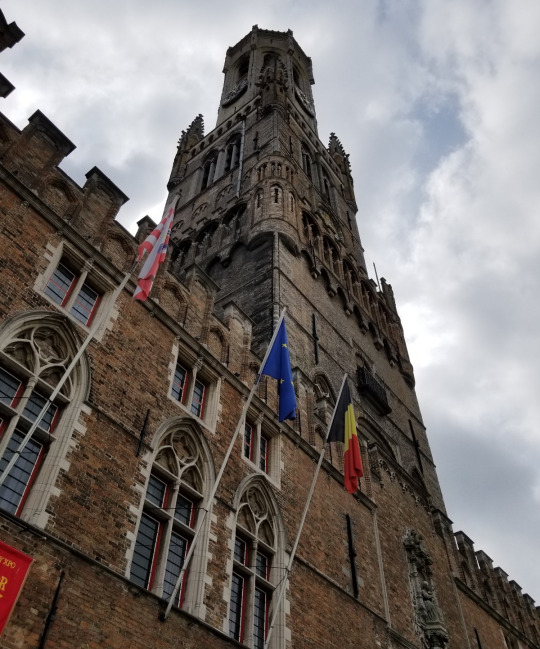
After a pretty intense day visiting the WWI battlefields and memorials of Flanders Fields, Jessica and I decided to spend our last day in Bruges enjoying some of the lighter things it had to offer: chocolate, fries, and a whopping bell tower.

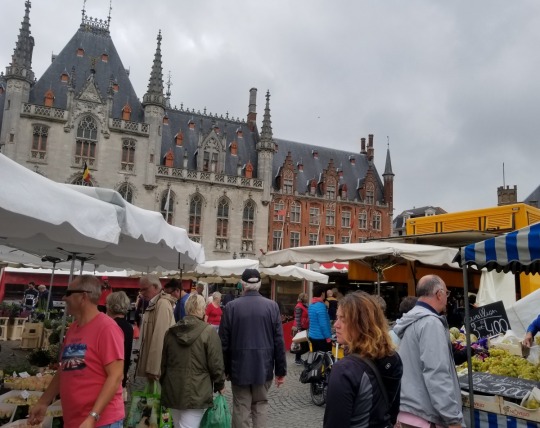

After a return trip to the I Love Coffee espresso bar and a walk through the market square---this time filled with stalls of flowers and produce---we started the day with a trip to Bruges's Choco-Story museum.

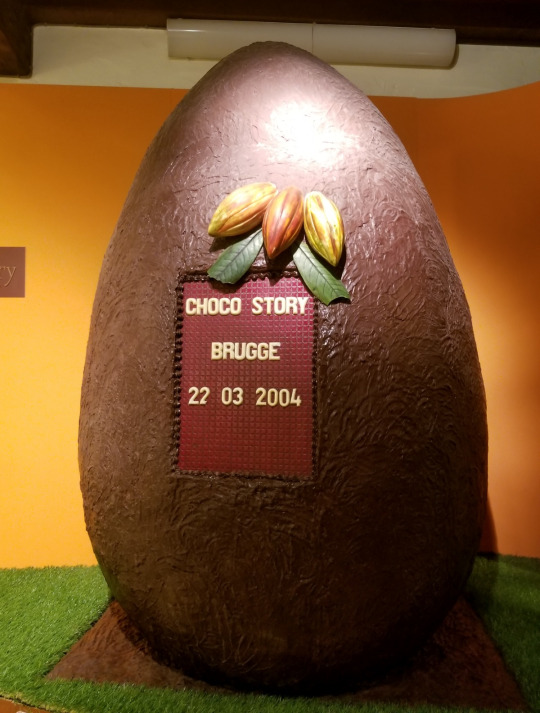
We'd visited a different chocolate museum back in York, so we were interested to see how the chocolate museum in this other world capital of chocolate compared. A lot of the subject material was similar---obviously---but we found the Bruges museum much more interesting. Instead of a flashy guided presentation like we experienced at the York Chocolate Story, the Bruges Choco-Story is an actual museum filled with informational displays that we could take in at our own pace.
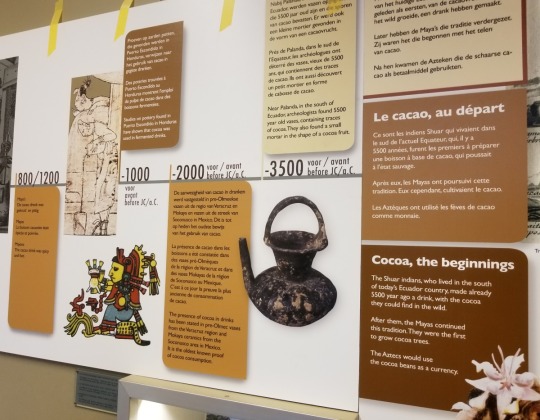
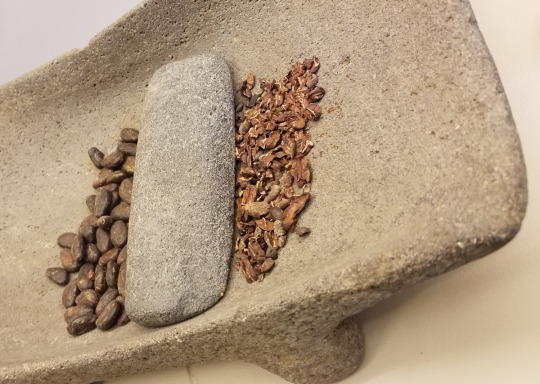
As we already knew, the earliest form of chocolate was a sort of cold bitter tea brewed in Central America from cocoa nuts.. What I hadn't known is that the word chocolate is derived from the Nahuatl (Aztec) word cacahuatl, meaning "cocoa water." The earliest known use of cocoa was by the Shuar people of Ecuador around 5,000 years ago. Archeologists have found traces of Shuar pottery still coated with traces of brewed cocoa.

The later Mayan and Aztec civilizations especially favored a type of foamed cocoa made by churning it with a special whisk. The foam apparently cut down the bitter taste of the unsweetened chocolate.
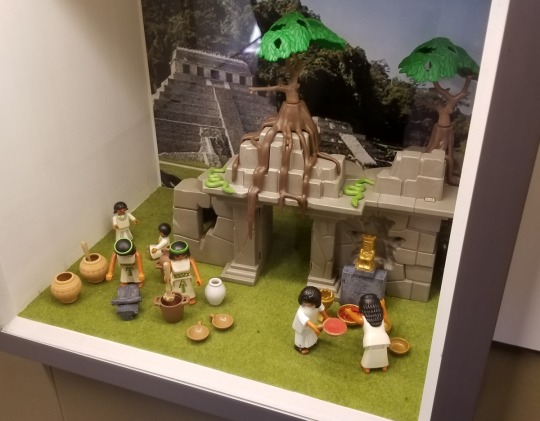
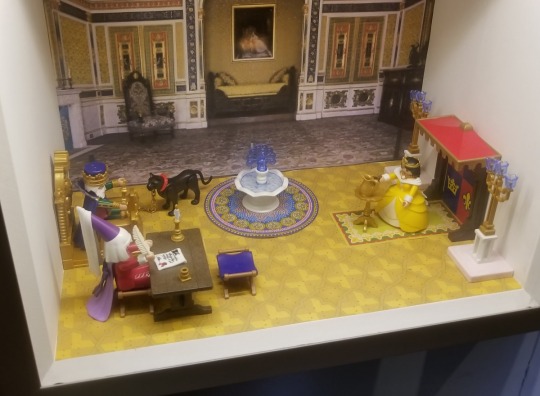
In addition to the more typical museum displays, the Choco-Story also had some delightful Duplo block dioramas.

Much later, Spanish nuns in Oaxaca were the first to add sugar to their cocoa. The drink became so popular among female Spanish colonists that they couldn’t even make it through church services without taking a break for their servants to bring them more. A local bishop tried to crack down on the problem by banning cocoa in church and was found murdered shortly thereafter. (An important lesson about men trying to get between a woman and her chocolate…)
It was nearly a century after Columbus’s first voyage before cocoa made it back to Spain, and it was another century after that before it became popular outside of Spain. But when it finally did, it quickly became a sensation across the continent. In the 1700s, the French philosopher Voltaire mixed cocoa with coffee to create the world’s first mocha. He drank over 40 cups of it per day---to his doctor’s great distress.

Apparently, people were so afraid of spilling their cocoa that a new type of saucer was invented with a basket or cup for holding the cup secure. Maybe they were so afraid of spilling it because it was so expensive. In 1800, a pound of chocolate cost five times the average daily wage.
It wasn't until the mid-1800s that solid chocolate as we know it was first developed by the Quakers of northern England, whom we'd learned about at the Chocolate Story in York. But even though the English invented solid chocolate, the Belgians would argue that they perfected it.



Belgian chocolatiers pioneered the use of fun shapes and fillings to make chocolates even more enjoyable. Belgium was also one of the first countries to impose strict purity laws governing the production of chocolate---sort of like what Bavaria did with beer centuries earlier.
We also learned a bit about the process of making chocolate. (Or rather, I learned, since Jessica was already well-versed in the making of chocolate as a former chocolatier herself.)
I learned that there are three main varieties of cocoa plant: Criollo, Forastero, and Trinitario. Of these, Criollo makes the best chocolate and Forastero makes the least-good chocolate. Still, Forastero is much easier to grow than the other two, so the vast majority of chocolate is made from Forastero beans.
On average, one cocoa tree produces enough nuts to make just one pound of dark chocolate per year. That means that it takes literally billions of cocoa trees to feed the world's sweet tooth.

They also had a diagram showing the composition of dark, milk, and white chocolate. I knew that milk chocolate has a lot more sugar and less cocoa than dark chocolate, but seeing the pie charts really drove the difference home for me.
We also got to eat as many sample pieces of dark, milk, and white chocolate as we wanted, which was nice.



The museum ended with a walk through some incredible chocolate statuary and a demonstration of how to make Belgian pralines. It was pretty much exactly like the demonstration we saw in York---the chocolatier filled a mold with chocolate, poured it out, filled with filling, then filled with chocolate. But it's always fun to see people make chocolate, and it's even better to get free samples afterward.

On our way out to the gift shop, a set of computer terminals offered to reveal our perfect origin chocolate based on our taste preferences. Apparently mine is Venezuela and Jessica’s is Vietnam.

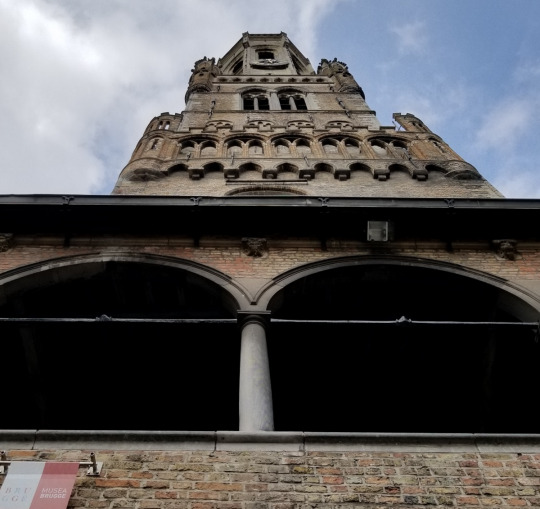
Our next stop was to climb the iconic bell tower that overlooks the market square. I have to admit that I spent a lot of that time thinking about the movie In Bruges, in which the tower plays a prominent role.
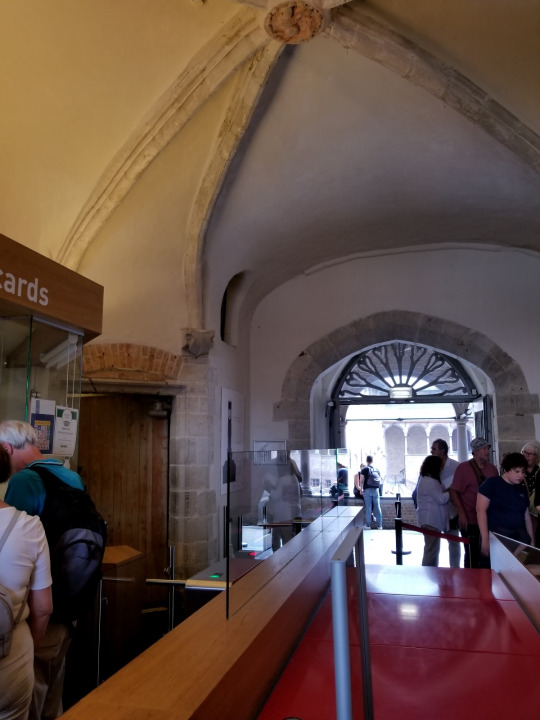
Crowds have apparently become more of an issue in the ten years since the movie was released. It was about a thirty-minute wait in the newly installed queue room before we could climb the tower. The price has also grown along with the crowds–twelve euros per person instead of the five quoted in the movie.

While we waited, we watched a looping video showing how the design of the tower has evolved over time. It was once actually even taller than it is now.
During the Middle Ages, a lot of towns around Belgium made deals with the local lords. The lords gave the towns economic autonomy, and the towns used this freedom to make astronomical amounts of money that the lords could use to raise armies when necessary. Each town had a market hall where local merchants would keep their wares safe during winter, and it became a point of pride for each town to build the biggest, most elaborate tower possible on their market halls.

As we climbed up, we got to see some exhibits along the way. We saw an old lock-box and the original wrought-iron doors dating back over 700 years to the hall’s original construction. Back in the day, this chest would have contained important contracts and decrees, and it would have required multiple respected members of the community to open it together, since they each would carry one of several keys that were all needed to open it.

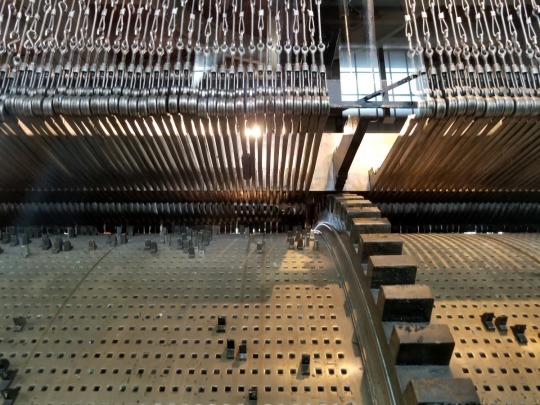
We also saw the giant brass cylinder that runs the tower’s carillon bells just like a music box. I hadn’t known before this trip that that was how they worked!

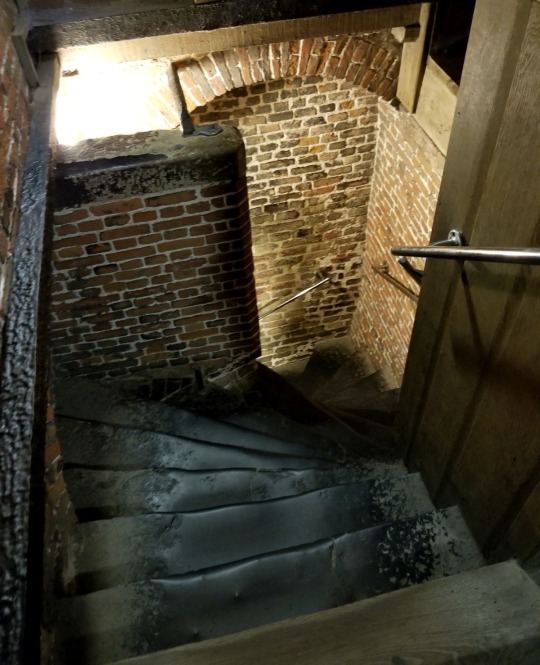
It's very clear from the inside how much the tower has been expanded and renovated over the centuries. The designs and angles of the staircase change dramatically every few floors or so, seemingly without any care for convenience or continuity. It clearly feels like a place that was originally intended to be behind the scenes and not seen by visitors.
Also, as far as I could tell, there wasn't any point along climb where the stairway matched the one shown in In Bruges. Oh well.

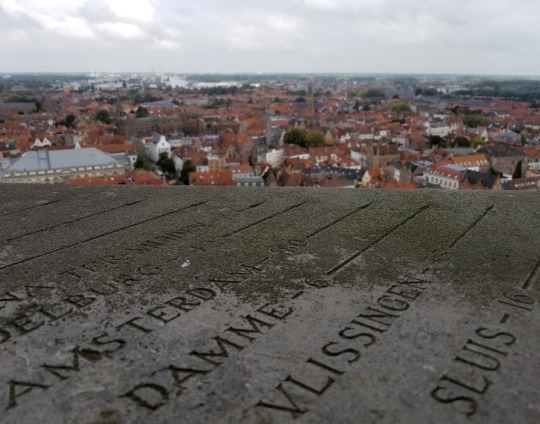
The view from the top of the tower was just as spectacular as we could have hoped. There was a web of wire mesh covering all the windows, possibly to prevent people from inadvertently reenacting the film’s climactic scene.


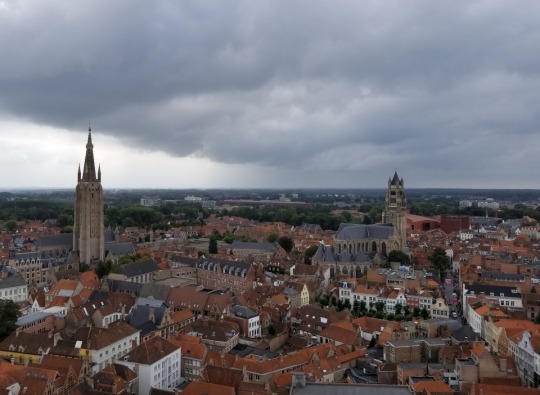
Still, we were able to get some spectacular shots of the surrounding town and skyline.
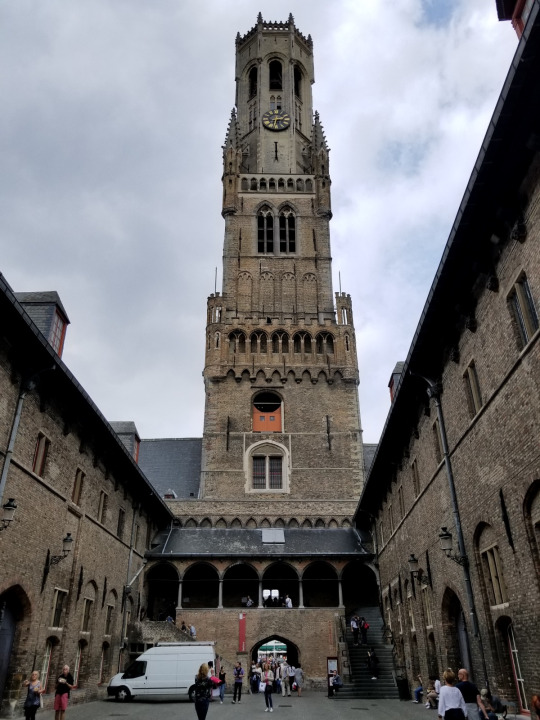

Back on the ground, we bought some fries at one of the stands flanking the entrance and sat down in the bell tower's courtyard. Fries are a big deal in Belgium, and there are dozens of condiments to choose from. There's the American staple of ketchup, the Belgian staple of mayonnaise, and a host of other sauces we'd never heard of before. Thankfully we had plenty of time in line to do some quick research on our phones.
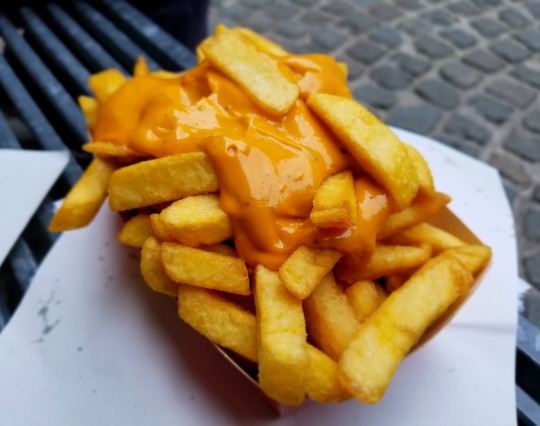
We both settled on “Andalouse sauce”–a blend of mayonnaise, tomato sauce, and peppers. If you've ever tried Red Robin's Campfire sauce before, it is very similar to that. They were easily the best fries either of us have ever had.
After doing a bit of final shopping in town, we headed back to our Airbnb to rest up and get packed for the next day's trip up to Amsterdam, where Jessica’s brother Nic was already waiting for us. We were leaving a day earlier than we had originally planned at the beginning of the trip since we'd gotten tickets to a soccer match in Amsterdam tomorrow night, but we still had a great time. Belgium seems to have a bit of a reputation for being an underwhelming tourist destination, but we had a fantastic time. The people were great, the food was great, the beer was great, and the scenery was great.
Speaking of beer, we didn't do any other beer-related activities after the De Halve Maan brewery tour, but we did our best to sample the local offerings back at our Airbnb in the evenings. We enjoyed a bottle of Kasteel Rouge, the cherry-liqueur-fortified dark ale we'd tasted back in Prague. Just like before, the first sip was heavenly, but each sip afterward was increasingly cloying. It would make a great digestif, but a full bottle---or even half a bottle---is far too much.
Another ale we enjoyed was the ubiquitous but still impressive Leffe Brown. It is the standard dubbel offering of the Belgian abbey-style macrobrewery Leffe, part of the Anheuser-Busch InBev family. But like I said, it is still really good. As long as you like dark ales, that is. The first thing that struck me was just how appropriate the name was. Sure, "Brown" doesn't seem like the most unique or descriptive name for a dark beer, but I can't think of a better word to encapsulate its flavor. It's earthy, bready, and nutty---like drinking a fermented organic bakery.
And of course, we got some Lambic beers. Jessica had gotten me into Lambic beers back when we were first planning this trip. Technically, Lambic beer is just beer that's produced in a very specific part of Belgium using wild yeast instead of brewer's yeast. But commercially, Lambic beers are known for being mixed with fruit syrups to create a deliciously refreshing beverage that even people who don't normally like alcohol can enjoy. The main brand you can find in the US is Lindeman's, and one of the first drinks we opened upon our arrival in Bruges was a Lindeman's Framboise (raspberry). It tasted pretty much the same as it does in the US--which could be seen as either mildly disappointing (since it wasn't any better) or moderately encouraging (we don't have to feel depressed for not getting "the good stuff" back home).
Plus, we also had a ton of chocolates we had to eat our way through. Yeah, life was pretty hard for us in Belgium. But all good things in this life must come to an end, even if it is only to move on to the next good thing. And the next good thing for us was Amsterdam, a family reunion, and my first European soccer match.
#180abroad#bruges#belgium#travel#chocolate#bell tower#french fries#architecture#europe#beer#lindeman#still in bruges
1 note
·
View note
Text
The Silence of the Girls
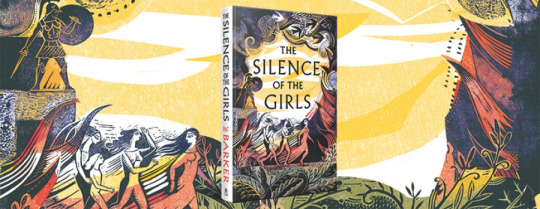
Pat Barker’s newish (August 2018) book The Silence of the Girls (TSOTG) recounts the final months of the Trojan War, as told by a slave woman. The obvious companion piece to TSOTG, and the key text Barker is responding to, is The Iliad, but Barker doesn’t pull out the way Homer did:
The Iliad only covers a few weeks in the last year of the war and does not include the famous Trojan horse or the actual defeat of Troy: at a high level, The Iliad covers Agamemnon’s lady troubles, the plague, Achilles’ sulking and decision not to fight, the death of Patroclus, Achilles’ return to battle, the death of Hector, the abuse of Hector’s body and Priam’s visit to Achilles.
TSOTG covers these events (also starting in media res - more on that later) from the perspective of Briseis. Our protagonist, formerly the wife of a king, was taken during the sacking of a city neighbouring Troy and was given to Achilles as a prize - like all of the women in the Greek camp, she is a slave. Barker and Briseis continue on after the burial of Hector to include the fall of Troy (no mention of the horse though...) and the rape and destruction which followed including the fate of Astyanax, the Trojan women being handed out as prizes, and the Greeks eventually setting off to return home.
I mention the famous events from the Trojan War above, but in TSOTG most of these happen off screen (out of our protagonist’s line of sight) and are reported to us as gossip spreading around the Greek camp. The reader is stuck in the camp with the women and doesn’t see any of the excitement and action on the battlefield (except for when Briseis climbs on the Myrmidon ships to see the battlefield in the distance). The reader is also privy to a lot of ‘girl talk’ amongst the women as they discus their experiences with the Greek soldiers: who’s pregnant, who’s beloved, who’s in favour. So despite hitting the same broad plot points, we are kept away from the iconic set pieces of the war, and instead get a tour through the backrooms where women do laundry, pray, and heal the injured soldiers.
When we studied Wide Sargasso Sea in high school, it became part of an interesting conversation on high-lit fan fiction: Jeans Rhys reveals the mysterious mad woman in Rochester’s attic, and she shows us how he drove her mad. More than a hundred years after Jane Eyre was published, Rhys, a Dominican author, chose to get into it with one of the stodgiest pieces of English literature out there. She introduced new themes of colonialism and undermined Rochester as the Byronic hero. I don’t think anyone will read Barker’s text that way - Homer’s works and the Bible are so canonical that referencing or interacting with them feels like it doesn’t count as fan fiction (has anyone ever argued that Paradise Lost was fan fic?). Because Barker is a serious author with a Booker Prize on her shelf, they call TSOTG a ‘retelling’ rather than fan fic, but what is more fan fic than recounting a famous story from another character’s perspective?
For reference: Stephanie Meyer has done this twice to her own novels. She retold Twilight from Edward’s POV in Midnight Sun and wrote a gender flipped version of Twilight called Life and Death: Twilight Reimagined. From Wikipedia, it seems like a pretty straight-forward find and replace job: Life and Death tells the story of 16 year old Beaufort Swan who moves from Arizona to Washington to live with his dad - on his first day at school, he meets the beautiful and mysterious Edythe Cullen...
youtube
^^ It’s fun to laugh at Twilight but remember this: Bon Iver recorded a song for the soundtrack. The New Moon soundtrack also featured Death Cab for Cutie, Thom Yorke, Grizzly Bear and a bunch of other bands with legitimate indie credibility (Pitchfork still gave it a 5.4) - why did they agree to be on this soundtrack? They must be getting approached for this kind of work all the time and New Moon’s budget was not huge - only $50 million so it’s not like they would have been offering obscene cash. Probably a mystery for another time...
Most of Barker’s works deal with war in some capacity. The only other book of hers which I’ve read is Regeneration. In that book, Barker riffs on historical figures, places, events, and literary works as she explores the impacts of WWI on returning English soldiers suffering PTSD. There are a lot of complicated ideas moving around and bumping up against each other - it’s like she’s playing a 20 string guitar or jamming out on a 40 piece drum kit or something: she’s just super masterful and it’s a good read but also interesting to look at how she achieved it technically. It’s a super satisfying book to explore and think about and probably my favourite war book (maybe tied with Slaughterhouse 5).
In TSOTG, she’s still interested in war, but now she’s looking more closely at the impacts of war on women. In a way, TSOTG seems kind of blunt and stupid in its handling of war compared to Regeneration. Barker is so focused on proving that women had it bad during the war and trying to deromanticise the Greek warriors, that she depicts all the men (except Patroclus and Achilles) as childish brutes: they’re capricious and proud, they’re rough and inconsiderate, they take offence easily, they eat messily and they drink too much. We never see them in action on the battlefield, so the one thing they’re good at is hidden from us: we don’t get to admire their magnificence but when they die, the women make fun of their shriveled cocks. Of course, we see this through Briseis’ biased eyes (fair enough given her situation), but what she reports of their behaviour is pretty bleak. No one has a rich interiority: they just fuck, shit and fight. It seems like Barker’s argument is that the men must be assholes because they rape their slaves. But we know that’s not how it works: the men raped their slave women because that was the cultural norm but beyond the raping they were average guys. In fact, the raping and slaving made them average. Not heroes, not assholes. Just 1100BC guys.*
(*This isn’t ‘boys will be boys’ - if anything it’s historical relativism. I’m not saying it’s average because they were guys, I’m saying it’s average because it was a long time ago. Remember, Jesus was a radical thinker with all his wacky ideas about compassion and love - and he was still more than a 1000 years away. The Greeks were very advanced in some ways, but their culture relied on slavery - at a point you need to accept that that was their normal (bad by our standards, yes) and engage with them on their own terms otherwise you’ll never get anywhere in a conversation about their values.)
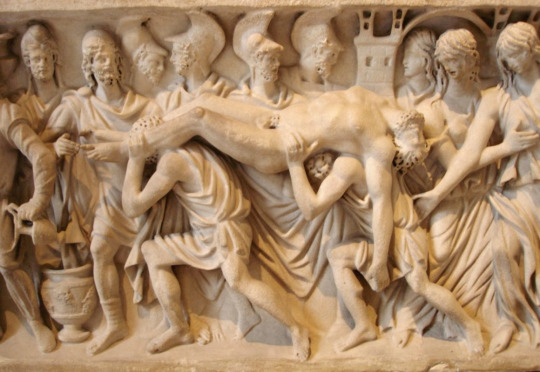
Barker retells this astonishing passage from The Iliad about three quarters of the way through TSOTG - just to set it up, Achilles killed Prince Hector and has been desecrating his corpse (dragging it behind his chariot) as vengeance for the death of Patroclus (Achilles’ closest friend). In ancient Greece, it was believed that you couldn’t pass on to the underworld until you’d had a proper burial. Beyond being disrespectful, the abuse of Hector’s body torments his family because it means Hector cannot pass peacefully to the afterlife. Growing desperate, Hector’s father King Priam has snuck out of Troy and come to the Greek camp to beg Achilles to return Hector’s body:
Priam found the warrior there inside ... many captains sitting some way off, but two, veteran Automedon and the fine fighter Alcimus were busy serving him. He had just finished dinner, eating, drinking, and the table still stood near. The majestic king of Troy slipped past the rest and kneeling down beside Achilles, clasped his knees and kissed his hands, those terrible, man-killing hands that had slaughtered Priam's many sons in battle. Awesome - as when the grip of madness seizes one who murders a man in his own fatherland and flees abroad to foreign shores, to a wealthy, noble host, and a sense of marvel runs through all who see him so Achilles marveled, beholding majestic Priam. His men marveled too, trading startled glances. But Priam prayed his heart out to Achilles: "Remember your own father, great godlike Achilles - as old as I am, past the threshold of deadly old age! No doubt the countrymen round about him plague him now, with no one there to defend him, beat away disaster. No one - but at least he hears you're still alive and his old heart rejoices, hopes rising, day by day, to see his beloved son come sailing home from Troy. But l - dear god, my life so cursed by fate ... I fathered hero sons in the wide realm of Troy and now not a single one is left, I tell you. Fifty sons I had when the sons of Achaea came, nineteen born to me from a single mother's womb and the rest by other women in the palace. Many, most of them violent Ares cut the knees from under. But one, one was left me, to guard my walls, my people the one you killed the other day, defending his fatherland, my Hector! It's all for him I've come to the ships now, to win him back from you - I bring a priceless ransom. Revere the gods, Achilles! Pity me in my own right, remember your own father! I deserve more pity ... I have endured what no one on earth has ever done before - I put to my lips the hands of the man who killed my son." Those words stirred within Achilles a deep desire to grieve for his own father. Taking the old man's hand he gently moved him back. And overpowered by memory both men gave way to grief. Priam wept freely for man-killing Hector, throbbing, crouching before Achilles' feet as Achilles wept himself, now for his father, now for Patroclus once again, and their sobbing rose and fell throughout the house.
(Not sure about this translation but it’s the best I could find online)
So this scene plays out beat for beat in TSOTG, and it’s very moving and well done (well done by Homer originally - and Barker renders it well too), but Barker wants to make it about the women so in response to Priam’s famous line ‘I kiss the hands of the man who killed my son’, Briseis thinks: "And I do what countless women before me have been forced to do. I spread my legs for the man who killed my husband and my brothers.” Is she an asshole for thinking about herself in this moment? I understand what Barker is trying to do: elevate the suffering of the women to the same platform that the men have always had. But this is graceless. It’s not a competition.
Another element I found frustrating was the suggestion in TSOTG that the Greeks regarded Achilles’ close bond with Patroclus as unusual - characters are scornful of Achilles’ relationship with Patroclus and make snickering jokes about them being gay. This is disappointing because I am sure Barker did her research and therefore she must know that ancient Greece was probably more accepting of homosexuality (at least between men) than society is today. The only whisper of controversy around their relationship was the ancient equivalent of the ‘who’s the bottom?’ question: the Greeks would have been curious about who was dominant and who was passive, but wouldn’t have raised an eyebrow at Patroclus and Achilles being together.
Frank Miller also choose to make his ancient Greeks homophobic in 300 and Alan Moore, always happy to play the expert, was quick to point out the mistake:
There was just one particular line in it where one of the Spartan soldiers—I'll remind you, this is Spartans that we're talking about—one of them was talking disparagingly about the Athenians, and said, ‘Those boy-lovers.' You know, I mean, read a book, Frank. The Spartans were famous for something other than holding the bridge at Thermopylae, they were quite famous for actually enforcing man-boy love amongst the ranks as a way of military bonding. That specific example probably says more about Frank's grasp of history than it does about his grasp of homosexuality, so I'm not impugning his moral situation there. I'm not saying it was homophobic; just wasn't very well researched.
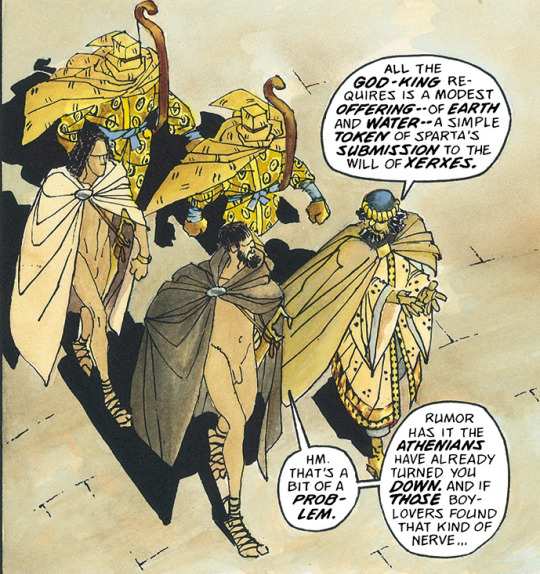
Anyone with even a passing knowledge of ancient Greece would be familiar with their permissive attitudes toward homosexuality. Why did she choose to do this? I know she’s not homophobic because Regeneration sensitively observed the suffering of gay men, for example that minor speech impediments (lisps, stutters) manifested in men who were repressing their homosexuality. I don’t understand this choice from a woman who wrote maybe the best war book of all time.
TSOTG wraps up with a reflection on memory and the stories people want to hear:
I thought: Suppose, suppose just once, once, in all these centuries, the slippery gods keep their word and Achilles is granted eternal glory in return for his early death under the walls of Troy...? What will they make of us, the people of those unimaginably distant times? One thing I do know: they won’t want the brutal reality of conquest and slavery. They won’t want to be told about the massacres of men and boys, the enslavement of women and girls. They won’t want to know we were living in a rape camp. No, they’ll go for something altogether softer. A love story, perhaps? I just hope they manage to work out who the lovers were. His story. His, not mine. It ends at his grave... Once, not so long ago, I tried to walk out of Achilles’ story - and failed. Now, my own story can begin.
Through the sickening dramatic irony, I can pick out three points Barker is trying to make:
Achilles looms large, but Briseis is her own person and deserves her own story
This is the untold true story of what really went down during the Trojan War - the people aren’t ready for this heat but I, Pat Barker, will bring it to them regardless
This isn’t a love story, but if it were, it would be the authoritative and definitive Trojan War love story
Point 1: Briseis deserves her own story
As I mentioned earlier, TSOTG begins in media res - meaning unlike in Troy, we don’t see what the gang was doing before the fighting kicked off, the catalysts of the war, the journey from Greece, etc. The action begins mid-way through the war, mid-way through a day, mid-way through a battle as our protagonist, mid-way through her life, peers over the parapets watching the Greeks disembowel her countrymen. So TSOTG begins as Achilles enters Briseis’ life and ends just as he leaves it - it begins in media res because no one would want to hear about her boring ass life before incandescent Achilles walked into it. Briseis is most interesting when she’s talking about Achilles, watching him from afar, describing their awkward encounters, analysing his behaviour - sure, the story is from Briseis’ perspective, but she’s always looking at Achilles. Is Barker arguing that we should care about Briseis outside of Achilles? She can’t have it both ways! She can’t complain that no one cares about anything but Achilles and then tell a story centered around Achilles, make Achilles the most interesting character and - in a particularly weird move - allow him to narrate some chapters in the second half of the book.
Point 2: This is the grittiest telling of the Trojan War that readers have ever had to grit their teeth through
The suggestion that this is ‘the untold true story of the women of Troy’ is totally bogus - exploring what the Trojan War cost women has been done. Euripides wrote the The Trojan Women in ~415BC, some 600+ years after when the Trojan War is estimated to have taken place (if it took place at all). It’s a tragedy which focuses on the Trojan women (Hecuba, Andromache and co.) as they process the death of their husbands, and learn what their fate will be (i.e. which Greek they will be gifted to). As with TSOTG, the action happens off-stage, out of the women’s line of sight and is reported to them by men as they come and go from the stage. It is a relentlessly horrible play: the centerpiece is the murder of Hector’s baby son Astyanax (Odysseus throws him from the walls of Troy) and the women’s response to this terrible news.
It seems like Barker also takes issue with modern narratives glossing over the rape, slaughter and slavery that occurred during the war - but even Troy (by no means an unromantic movie) makes these elements pretty explicit:
youtube
In the clip above, the Myrmidons have brought Achilles the newly enslaved Briseis in case he would like to rape her. The slavery and rape threat elements are there. Is Barker saying that she wants to see the rape? Does this scene somehow read as romantic because he chooses not to rape her? Rape is being used more and more, especially in TV, as a way of creating realism in fantasy shows - and people do seem to have an appetite for it (see: Game of Thrones, Outlander). So her suggestion that modern audiences want a sanitised version of the war doesn’t work for me.
Point 3: This isn’t a love story. It’s about rape. But also... don’t you just love Achilles?
Quoting from Briseis’ final words again:
No, they’ll go for something altogether softer. A love story, perhaps? I just hope they manage to work out who the lovers were.
Sounds pointed. Barker is implying someone out there got the lovers wrong. It can’t be Troy because they went with the Achilles/Briseis angle too, so is she referring to Madeline Miller? Miller’s 2011 novel The Song of Achilles is a love story focused on Patroclus and Achilles (disclosure: I haven’t read it). As I mentioned earlier, Barker, going against all evidence we have about ancient Greece, chose to make her Greeks homophobic. She does touch on Achilles and Patroclus’ famous intimacy, but frames it more as some kind of preternatural closeness which goes beyond brothers or lovers. In Barker’s defence, Homer never explicitly said that Achilles and Patroclus were lovers, but the suggestion of it is certainly part of the canon. I had a high school Classics teacher who scoffed at Troy because she thought Achilles should have been banging Patroclus instead of Briseis.
Also: since we’re talking about a ‘rape camp’, were there really many lovers?
For a feminist take on The Iliad, this book has some weird gender politics. Achilles rapes our protagonist - a lot. He’s childish, he has mummy issues, he’s abrasive and fussy - but we want Briseis to win him over! We want Achilles to notice her. He’s so magnetic, even if you write him as a spoiled pig, he’s still Achilles. He’s the coolest guy in school. He’s the rower with big shoulders. He wears his hat backwards. He comes to school on Monday with a black eye. He doesn’t know anything about computers. He says he likes Hemingway. He smells good without deodorant. His socks never stay up. If you walk beside him in a hallway, you can feel heat radiating from his body. His pouting and brattiness play into his magnetism somehow. I honestly think Barker might have fallen into the same trap as high school girls throughout history: we just love a bad boy. Want a glimpse into the terrifying mind of teenage girl? When I was 17, I dumped my high school boyfriend because he wasn’t enough like Achilles or Hector. People are romantic about the Trojan War, but that doesn’t mean they want a love story.
#Homer#Troy#Trojan War#Pat Barker#The Silence of the Girls#Regeneration#Achilles#Briseis#Wide Sargasso Sea#Jean Rhys#Jane Eyre#Twilight#300#Frank Miller#alan moore
11 notes
·
View notes
Text

1 ‣ // Steve Rogers Files : Motivation
✪——If Steve hadn't gotten the serum back in ’42, he probably wouldn't have lived to be much older. He had such severe illnesses that they would've eventually killed him in five or ten years, at most. He really wasn't a good marriage prospect because of that as well as the fact it was difficult for him to hold down a job because of his health.
He never really dreamt of having a family back then, he assumed that wasn’t something he was ever going to get. The idea that he could die pretty much anytime was a large part of what motivated him to want to fight in the war.
He wanted his death to mean something.
That's why he didn't hesitate at all to be Erskine's test subject. Even if it went wrong, he figured Erskine would learn something from it and his death wouldn't be in vain.
Steve's mom died of tuberculosis because she cared for people who had it and his father died in WWI—both those deaths had meaning in Steve’s eyes and he couldn't tolerate the idea of just dying because his body was no good—that would be completely meaningless and useless.
He wanted to make a difference in the only way that made sense to him, he wanted his death—which was, as far as he was concerned, imminent—to make a difference. Whether that was taking a bullet for some other guy on the front lines—who might live to go home and see his baby—or dying in Erskine’s experiment and helping the next guy who tried it survive, that was enough.
At least with Erskine’s experiment, there was hope that it might work and he could do even more to make his life (or death) even more meaningful.
That was why, even though the USO tour was theoretically “helping" by selling war bonds, he felt like his chance to truly do something meaningful had been taken away. He was on a stage, while other guys—like Bucky—were fighting and dying on the battlefield. He’d gotten this gift and the potential to do so much more than he ever dreamt and then he wasn’t allowed to use it.
When he found out Bucky was in trouble—his best friend who had saved him a hundred times at least—he had to use what was given to him to help. Dying was nothing—he’d thought he was going to die since he was old enough to understand what it meant. In the face of feeling useless and like what he does will never matter, he’d rather face death again.
His illness and his parents’ selflessness are ultimately what has shaped Steve’s entire life.
#steve › headcanon series#›› headcanons. // not a perfect soldier#maddie does meta#headcanons#›› queue. // start running and never stop
1 note
·
View note
Video
youtube
My first attempt at @petermckinnon #pmedgarwrightchallenge which we will use in our full #film which will be out tomorrow night on @youtube of the tour across the #battlefield of #wwii & #wwi with #landroverdiscovery #landroverphotos #onelifeliveit #getoffthetarmac #getofftheroad #landroverdiscovery4 #adventuretime #adventure #PMEDGARWRIGHTCHALLENGE https://youtu.be/SbxY0iReJYo via @YouTube Peter Mckinnon B-ROLL Challenge Landrover Trip #PMEDGARWRIGHTCHALLENGE
#pmedgarwrightchallenge#My first attempt at @petermckinnon pmedgarwrightchallenge which we will use in our full film which will be out tomorrow night on @youtube of
1 note
·
View note
Text
WWI Battlefield Tours
The discovery of a relative who served on the Western Front piques the desire of many people who wish to visit the battlefields via WWI battlefield tours.
Following the footsteps of a First World War serviceman or woman is an enthralling way to learn about the battlegrounds and may be a truly affecting experience.
If you want to join an organised battlefield trip, be sure you can be transported to the gravesite before you register and travel with the tour. Most tours can organise a visit to a cemetery or memorial within a reasonable walking distance of the tour's schedule.
If the location you want to visit is remote or unreachable by coach, Travel England Tours tour organiser may need to assist you in making arrangements for a taxi or other mode of transportation. In either case, you must address any unique requirements with the Travel England Tours tour organiser prior to your trip.
0 notes
Text
https://www.thefirearmblog.com/blog/2020/11/09/arsenals-history-virtual-summit/
If you’re looking for something to take your mind off of the craziness that is 2020 then the Cody Firearms Museum may have the event just for you. While there looks to be the second round of lockdowns on the horizon for some of us, the historians at the Cody Firearms Museum will be hosting the online Arsenals of History Virtual Summit event on November 14th between 10am and 5pm EDT.
Arsenals of History Virtual Summit by the Cody Firearms Museum TFB reached out to the Curator of the Cody Firearms Museum, Danny Michael, and he had this to say about the upcoming summit: We’re excited for the symposium to go virtual because it opens it up to people and museums that we couldn’t reach if we did in person only. Obviously, things will be a bit different, but people that come will have a great chance to see some museums and collections from afar and talk directly to the people that manage them. That’s a pretty unique opportunity.
SCHEDULE During the free event, the historians will take you on a full tour of the Cody Firearms Museum which is home to over 7,000 firearms from throughout history as well as over 30,000 firearms-related artifacts (like the elusive Wingo ice ball maker that we talked about on The Rimfire Report.) This stop on the virtual summit is sure to please any firearms enthusiast with a penchant for history. Entrance to the newly refurbished Cody Firearms Museum (Matthew Moss) After a brief lecture on Museums and Gun Laws, another tour will be provided this time to a super rare look at the Smithsonian Vault. The Smithsonian Vault has over 7,000+ guns in their inventory as well as 150 firearms that are on display throughout the various branches of the Smithsonian Institution. The National Firearms Collection of the Smithsonian was established in 1876 and is one of the most inaccessible firearms repositories unless you are a scholar or a dignitary. This virtual tour will probably be your best bet at getting a peek into the enigmatic vault.
During “lunch” there will be a special guest appearance by Ian McCollum from the Forgotten Weapons YouTube channel. TFBTV regulars will know that Forgotten Weapons and TFBTV have teamed up in the past to bring you some good content.
After lunch, there will be an additional tour of the Mob Museum (National Museum of Organized Crime & Law Enforcement). This tour should give you a good look into the history of Organized Crime within the United States and its impact on American Society. To cap off the virtual summit there will be some brief gameplay by the historians of the Cody Firearms Museum where they’ll Play Battlefield I (a WWI Themed First Person Shooter) along with Royal Armouries and they will judge the firearms presented within the game. Finally, there will be an hour-long clinic on how to care for your personal firearms collection followed by Happy Hour History where attendees will be able to participate in the conversation and enjoy a virtual drink with the historians. The Arsenals of History Virtual Summit will be free to the public. A link to the event can be obtained by submitting an RSVP to [email protected] before November 11th. On the day of the event, you will be provided a link where you can join in on the summit.
0 notes
Text
Doctor Who: Twice Upon A Time - Mark Gatiss Video Diaries

The BBC has released a behind the scenes video clip for the Doctor Who Christmas special, Twice Upon a Time, where Mark Gatiss takes us on a personal tour of the Ruins of Villengard and the WWI battlefield locations in his video diary.
NOTE: The following clip contains mild spoilers for those who have not yet seen Twice Upon A Time.
youtube
Doctor Who returns in 2018.
#doctor who#christmas special#twice upon a time#behind the#mark gatiss#peter capaldi#david bradley#videos
7 notes
·
View notes